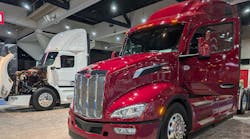Keep it clean: How basic fleet habits reduce accidents and lower insurance costs
Key takeaways
- Clean cabs, windshields, and routine maintenance reduce accident risk and support lower insurance premiums.
- Continuous MVR checks, telematics, and driver coaching reduce preventable accidents and improve fleet safety.
- Setting personal-use policies and celebrating safe-driving milestones strengthen safety culture and operational control.
Want to reduce accidents and keep insurance costs low? Start with the windshield.
It sounds simple, but the risks are substantial: The average fleet vehicle crash now exceeds $90,000, and that’s before considering injury claims that could climb into the millions. According to Pie Insurance’s 2025 State of Workplace Safety Report, 42% of businesses with commercial vehicles reported an accident in the past year, with average out-of-pocket costs topping $5,700 per incident and annual losses approaching $16,000 once insurance and legal fees are factored in.
Yet despite these stakes, basic safety measures often remain overlooked. Pie’s survey reported that two-thirds of small businesses rely on vehicles for daily operations, yet one in five still don’t monitor driver behavior, despite the proven benefits of telematics and standardized maintenance. The fundamentals matter just as much: Clean windshields, tidy cabs, and vehicles that receive routine maintenance aren’t mere nice-to-haves. They’re a component of what separates manageable fleet claims from fleets that struggle at renewal time.
This isn’t about launching a new program or adding more technology to complicate the process. It’s about reinforcing the habits that keep drivers alert, vehicles running smoothly, and claims off the books. With these simple everyday steps, you’ll not only lower your risk but also show your insurer that you’re genuinely committed to safety.
Daily fleet practices that cut accidents and improve operational efficiency
Companies may understand that it’s critical to review motor vehicle reports (MVRs), driver behavior, and employ telematics where possible. However, a cluttered cab, a missed brake check, or a forgotten trip log doesn’t just reflect operational oversight; it can increase risk.
Getting back to the basics is essential.
- Hire clean: Check MVRs before hiring, and use continuous monitoring to catch new violations as they occur. Don't rely on annual checks alone. Violations and suspensions can occur at any time, and continuous monitoring ensures you’re aware of them immediately, not months later during an audit or after a crash.
- Train regularly: Defensive driving courses can help, but there’s no substitute for ride-alongs and one-on-one coaching. That’s where you can catch the small stuff before it turns into a claim. Research on National Safety Council defensive driving courses showed that participants achieved up to 74% decreases in traffic violation rates, with the benefits lasting a full year after completion.
- Use tech wisely: Telematics and dashcams can also be be used for accountability and coaching, not just catching people when they do something wrong but praising them when they do it right. Studies show that telematics systems can reduce accident occurrences by 20-30%, and fleets that actively use driver scoring have seen an 8% reduction in preventable accidents for every 10% improvement in driver safety scores.
- Follow your maintenance schedule: Preventive maintenance isn’t optional. Our team has seen too many fleets ignore routine things like brakes, tires, and lights because they are too busy, or it's not prioritized as part of checks. According to the Federal Motor Carrier Safety Administration's Large Truck Crash Causation Study, over one-third of commercial trucks inspected after crashes had maintenance defects that would have placed them out of service, with brake problems found in 32.7% of trucks.
- Set boundaries on personal use: Approximately 60% of company vehicle crashes occur after hours. If you are allowing employees to take vehicles home at night or use the company car for personal use, then ensure that you have trip logs and GPS on (where necessary) and clear policies in place.
- Celebrate the wins: Clean inspections, milestone-free quarters, carriers whose drivers consistently show up and perform their duties correctly. None of this is revolutionary, but it works.
The business case for clean, well-maintained commercial vehicles in risk management
Commercial auto insurance is not only expensive but also under close scrutiny. Roadway incidents are the leading cause of work-related deaths, with 1,252 workers dying in vehicle-related crashes in 2023 alone. Underwriters want an idea of how you handle risk on a moment-by-moment basis. They’re asking about maintenance schedules, MVR policies, and how often you coach drivers on their performance. Fleets that regard these as afterthoughts often have more claims and fewer available options at renewal, as well as increased premiums, operating costs, and more overhead. Fleets that remain disciplined and proactive, however, may receive better pricing, greater coverage flexibility, and longer carrier relationships. You're not just checking boxes; you are demonstrating that you’re a lower-risk bet.
Cleaner habits equal better results. They often minimize distractions, create clear expectations, and help build a culture where safety is not just a poster on the wall but the way things are done. If you would rather have fewer claims and more control, a complete overhaul is not necessary. Just go back to basics: Clean the cab, stick to the maintenance schedule, delve deeper into your driver data, and set the standard. In this setting, cleanliness is not about looking good. It is about protecting your people, reputation, and business.
About the Author

Mike Hickey
Mike is the director of commercial auto at Pie Insurance, where he leads efforts to make coverage more accessible and affordable for small businesses. He’s worked in the insurance industry since 2012, bringing firsthand experience from both retail agencies and national carriers.


